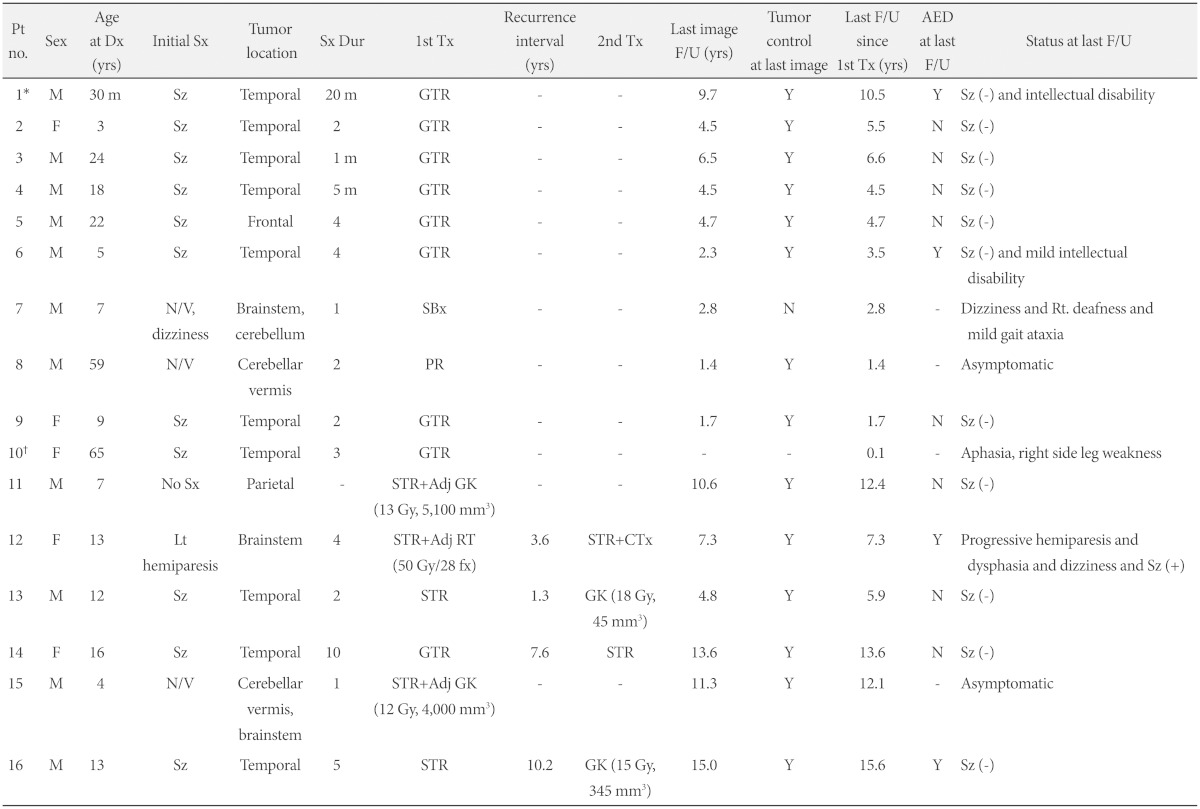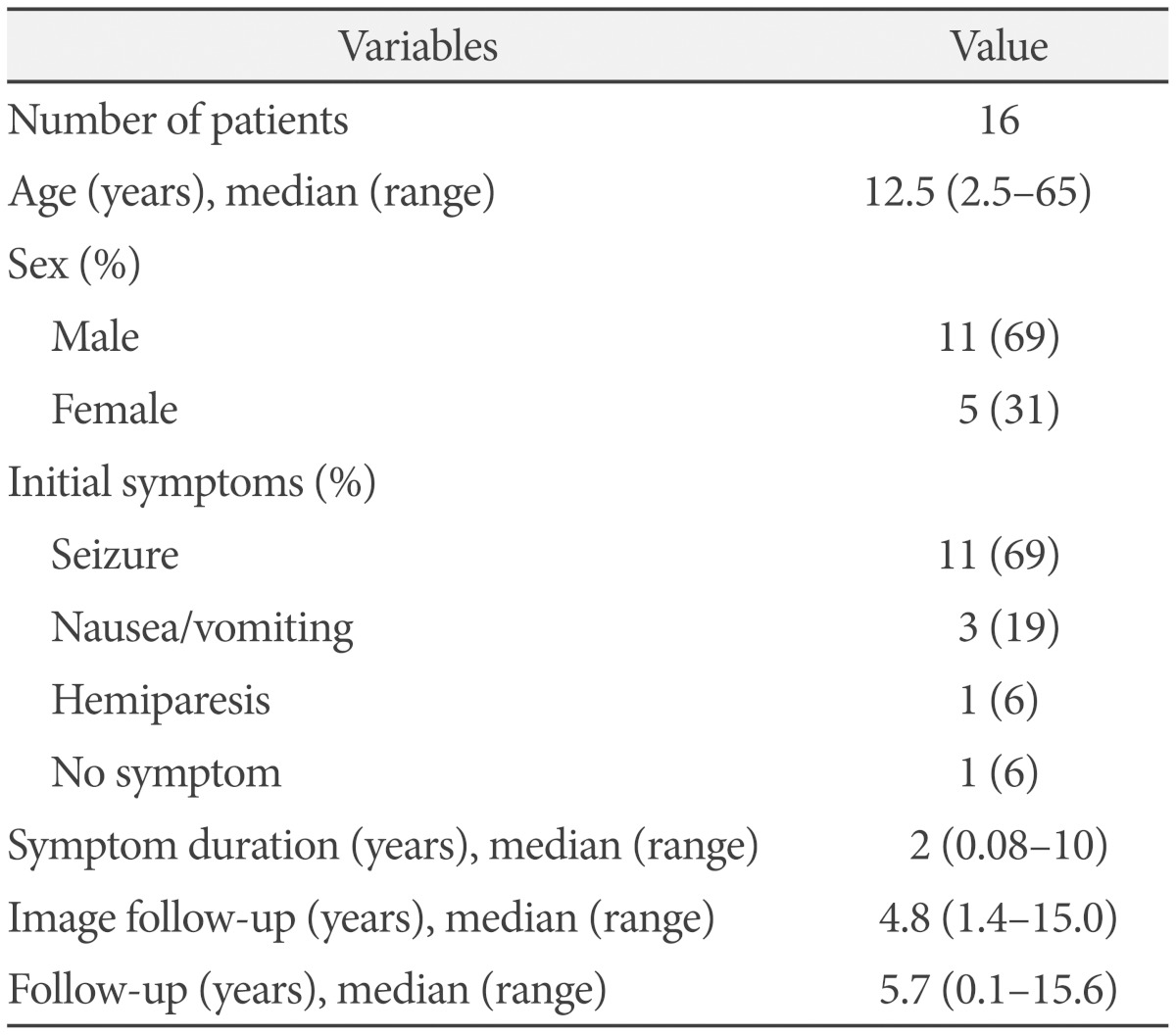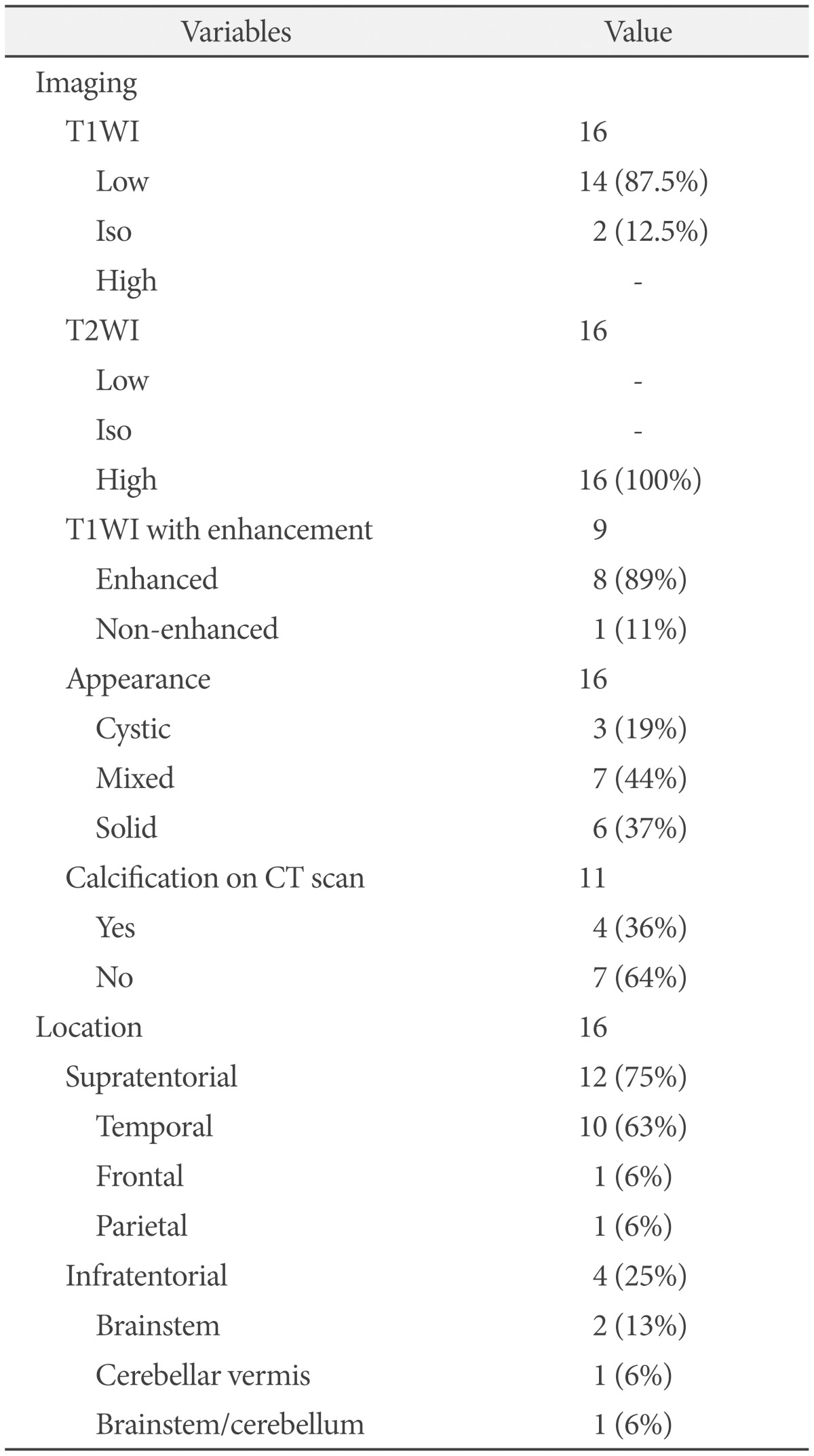1. Zhang D, Henning TD, Zou LG, et al. Intracranial ganglioglioma: clinicopathological and MRI findings in 16 patients. Clin Radiol. 2008; 63:80–91. PMID:
18068794.

2. Bevilacqua G, Sarnelli R. Ganglioglioma of the spinal cord. A case with a long survival. Acta Neuropathol. 1979; 48:239–242. PMID:
525264.
3. Karamitopoulou E, Perentes E, Probst A, Wegmann W. Ganglioglioma of the brain stem: neurological dysfunction of 16-year duration. Clin Neuropathol. 1995; 14:162–168. PMID:
7671459.
4. Scalley JR. Ganglioglioma of the cerebellum: angiographic findings. Rocky Mt Med J. 1976; 73:80–82. PMID:
951566.
5. Zentner J, Wolf HK, Ostertun B, et al. Gangliogliomas: clinical, radiological, and histopathological findings in 51 patients. J Neurol Neurosurg Psychiatry. 1994; 57:1497–1502. PMID:
7798980.

6. Blümcke I, Wiestler OD. Gangliogliomas: an intriguing tumor entity associated with focal epilepsies. J Neuropathol Exp Neurol. 2002; 61:575–584. PMID:
12125736.

7. Rumana CS, Valadka AB. Radiation therapy and malignant degeneration of benign supratentorial gangliogliomas. Neurosurgery. 1998; 42:1038–1043. PMID:
9588548.

8. Schittenhelm J, Reifenberger G, Ritz R, et al. Primary anaplastic ganglioglioma with a small-cell glioblastoma component. Clin Neuropathol. 2008; 27:91–95. PMID:
18402388.

9. Hall WA, Yunis EJ, Albright AL. Anaplastic ganglioglioma in an infant: case report and review of the literature. Neurosurgery. 1986; 19:1016–1020. PMID:
3808232.

10. Silver JM, Rawlings CE 3rd, Rossitch E Jr, Zeidman SM, Friedman AH. Ganglioglioma: a clinical study with long-term follow-up. Surg Neurol. 1991; 35:261–266. PMID:
2008640.

11. Mickle JP. Ganglioglioma in children. A review of 32 cases at the University of Florida. Pediatr Neurosurg. 1992; 18:310–314. PMID:
1476942.
12. Engel J Jr, Van Ness PC, Rasmussen TB, Ojemann LM. Outcome with respect to epileptic seizures. In : Engel J, editor. Surgical treatment of the epilepsies. 2nd ed. New York: Raven Press;1993. p. 609–621.
13. Isimbaldi G, Sironi M, Tonnarelli GP, Roncoroni M, Declich P, Galli C. Ganglioglioma: a clinical and pathological study of 12 cases. Clin Neuropathol. 1996; 15:192–199. PMID:
8836603.
14. Haddad SF, Moore SA, Menezes AH, VanGilder JC. Ganglioglioma: 13 years of experience. Neurosurgery. 1992; 31:171–178. PMID:
1513423.
15. Koeller KK, Henry JM. From the archives of the AFIP: superficial gliomas: radiologic-pathologic correlation. Armed Forces Institute of Pathology. Radiographics. 2001; 21:1533–1556. PMID:
11706224.
16. Ildan F, Tuna M, Göçer IA, Erman T, Cetinalp E. Intracerebral ganglioglioma: clinical and radiological study of eleven surgically treated cases with follow-up. Neurosurg Rev. 2001; 24:114–118. PMID:
11485231.

17. Kalyan-Raman UP, Olivero WC. Ganglioglioma: a correlative clinicopathological and radiological study of ten surgically treated cases with follow-up. Neurosurgery. 1987; 20:428–433. PMID:
3574619.

18. Ventureyra E, Herder S, Mallya BK, Keene D. Temporal lobe gangliogliomas in children. Childs Nerv Syst. 1986; 2:63–66. PMID:
3731171.
19. Pilcher WH, Silbergeld DL, Berger MS, Ojemann GA. Intraoperative electrocorticography during tumor resection: impact on seizure outcome in patients with gangliogliomas. J Neurosurg. 1993; 78:891–902. PMID:
8487071.

20. Castillo M, Davis PC, Takei Y, Hoffman JC Jr. Intracranial ganglioglioma: MR, CT, and clinical findings in 18 patients. AJNR Am J Neuroradiol. 1990; 11:109–114. PMID:
2105590.

21. Safavi-Abbasi S, Di Rocco F, Chantra K, et al. Posterior cranial fossa gangliogliomas. Skull Base. 2007; 17:253–264. PMID:
18174926.

22. Lagares A, Gómez PA, Lobato RD, Ricoy JR, Ramos A, de la Lama A. Ganglioglioma of the brainstem: report of three cases and review of the literature. Surg Neurol. 2001; 56:315–322. discussion 322-4. PMID:
11750003.
23. Luyken C, Blümcke I, Fimmers R, Urbach H, Wiestler OD, Schramm J. Supratentorial gangliogliomas: histopathologic grading and tumor recurrence in 184 patients with a median follow-up of 8 years. Cancer. 2004; 101:146–155. PMID:
15222000.

24. Liauw SL, Byer JE, Yachnis AT, Amdur RJ, Mendenhall WM. Radiotherapy after subtotally resected or recurrent ganglioglioma. Int J Radiat Oncol Biol Phys. 2007; 67:244–247. PMID:
17045420.

25. Ulutin HC, Ongürü O, Pak Y. Postoperative radiotherapy for ganglioglioma; report of three cases and review of the literature. Minim Invasive Neurosurg. 2002; 45:224–227. PMID:
12494357.

26. Zorlu F, Selek U, Onal C, Söylemezoğlu F, Gurkaynak M. Postoperative radiotherapy in cranial ganglioglioma. J Neurooncol. 2006; 77:321–324. PMID:
16314944.

27. Im SH, Chung CK, Cho BK, et al. Intracranial ganglioglioma: preoperative characteristics and oncologic outcome after surgery. J Neurooncol. 2002; 59:173–183. PMID:
12241112.
28. Hakim R, Loeffler JS, Anthony DC, Black PM. Gangliogliomas in adults. Cancer. 1997; 79:127–131. PMID:
8988736.

29. Tarnaris A, O'Brien C, Redfern RM. Ganglioglioma with anaplastic recurrence of the neuronal element following radiotherapy. Clin Neurol Neurosurg. 2006; 108:761–767. PMID:
16219416.

30. Mittelbronn M, Schittenhelm J, Lemke D, et al. Low grade ganglioglioma rapidly progressing to a WHO grade IV tumor showing malignant transformation in both astroglial and neuronal cell components. Neuropathology. 2007; 27:463–467. PMID:
18018481.

31. Rumana CS, Valadka AB, Contant CF. Prognostic factors in supratentorial ganglioglioma. Acta Neurochir (Wien). 1999; 141:63–68. discussion 68-9. PMID:
10071688.

32. Lang FF, Epstein FJ, Ransohoff J, et al. Central nervous system gangliogliomas. Part 2: clinical outcome. J Neurosurg. 1993; 79:867–873. PMID:
8246055.
33. Majores M, von Lehe M, Fassunke J, Schramm J, Becker AJ, Simon M. Tumor recurrence and malignant progression of gangliogliomas. Cancer. 2008; 113:3355–3363. PMID:
18988291.

34. Wolf HK, Müller MB, Spänle M, Zentner J, Schramm J, Wiestler OD. Ganglioglioma: a detailed histopathological and immunohistochemical analysis of 61 cases. Acta Neuropathol. 1994; 88:166–173. PMID:
7985497.

35. DeMarchi R, Abu-Abed S, Munoz D, Loch Macdonald R. Malignant ganglioglioma: case report and review of literature. J Neurooncol. 2011; 101:311–318. PMID:
20524041.

36. Johannsson JH, Rekate HL, Roessmann U. Gangliogliomas: pathological and clinical correlation. J Neurosurg. 1981; 54:58–63. PMID:
7463121.

37. Morris HH, Matkovic Z, Estes ML, et al. Ganglioglioma and intractable epilepsy: clinical and neurophysiologic features and predictors of outcome after surgery. Epilepsia. 1998; 39:307–313. PMID:
9578050.

38. Park YS, Kim DS, Shim KW, Kim JH, Choi JU. Factors contributing to resectability and seizure outcomes in 44 patients with ganglioglioma. Clin Neurol Neurosurg. 2008; 110:667–673. PMID:
18499337.

39. Im SH, Chung CK, Cho BK, Lee SK. Supratentorial ganglioglioma and epilepsy: postoperative seizure outcome. J Neurooncol. 2002; 57:59–66. PMID:
12125968.





 PDF
PDF ePub
ePub Citation
Citation Print
Print





 XML Download
XML Download